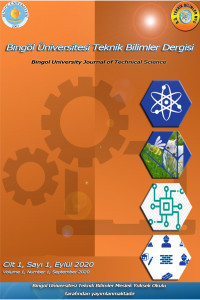Sürtünme Karıştırma Saplama Kaynak Metodu ile Birleştirilen AISI 5140 Çeliği ile AISI 316 Paslanmaz Çeliğin Mikroyapısal Özelliklerinin Belirlenmesi
Bu çalışmada, sürtünme karıştırma saplama kaynağı ile birleştirilmiş AISI 5140 ısıl işlem görmüş çelik ve östenitik paslanmaz çelik AISI 316’ nın birleştirilebilirliği araştırılmıştır. Bu çelikler farklı özelliklere sahip olmalarının yanı sıra endüstriyel uygulamalarda yaygın olarak kullanılmaktadır. Freze tezgâhı ile 1000, 1500 ve 2000 devir/dakika devir sayısı ve 8 ve 10 saniye sürtünme süresi parametreleri ile çeliklere sürtünme kaynağı yapılmıştır. Kaynak işleminden sonra, kaynaklı numunelerin sertlik mukavemetini belirlemek için sertlik testi uygulanmıştır. Kaynak sonrası mikroyapısal özellikleri belirlemek için optik mikroskop kullanılmış ve taramalı elektron mikroskobu (SEM) ile enerji-dağıtıcı (EDS), Xray spektroskopisi analiz testleri yapılmıştır. Sürtünme karıştırma saplama ile sorunsuz bir şekilde birleştirilen AISI 316 ve AISI 5140 çeliklerinden elde edilen veriler değerlendirilmiştir. Farklı özelliklere sahip olan bu çelikler başarılı bir şekilde birleştirilmiştir.
Investigation of Microstructural Properties of 5140 Steel with 316 Stainless Steel Joined by Friction Stir Stud Method
This study investigated the joinability of AISI 5140 heat treatable steel and AISI 316 austenitic stainless steel joined by friction stir stud welding. Besides having different properties, these steels are widely used in industrial applications. Weldings was applied on steels with the parameters of 1000, 1500 and 2000 rev/min turning speed and 8 and 10 sec friction time by milling machine. After the welding process, hardness testing was applied to determine hardness strength of welded samples. Additionally, in order to determine the microstructural features, the optical microscope was used with scanning electron microscope (SEM) energy-dispersive (EDS), Xray Spectroscopy analysis tests were done. The data obtained from AISI 316 and AISI 5140 steels that are seamlessly joined with friction stirring studs were evaluated. These steels with different properties have been successfully combined.
Keywords:
FSSW, Hardness, Microstructure, AISI 5140, AISI 316,
___
- https://www.thebalance.com/metal-profile-austenitic-stainless-2340126.
- Brooks JA, Lippold JC. Selection of wrought austenitic stainless steels. ASM Metal Handbooks. Materials Park, Ohio, USA 1993;6:456-469.
- Lippold JC, Kotechi DJ. Welding metallurgy and weldability of stainless steels. Wiley-Interscience. USA: 2005.
- JesudossHynes NR, Nagaraj P, JennifaSujana JA. Ultrasonic evaluation of friction stud welded AA 6063/AISI 1030 steel joints. Materials & Design 2014;62:118-123.
- Wilson J. The development of welding techniques for British fighting vehicles.In: The welding inst. proc. trends in steels and consumables for welding int.conf. 1978: 473–9.
- Celik S, Ersozlu I. Investigation of the mechanical properties and microstruc-ture of friction welded joints between AISI 4140 and 1050 steels. Mater Des 2009;30:970–6.
- Serkan B, Musa K, İhsan K. Friction welding of dissimilar AISI 304 And AISI 8640 steels. European Journal of Technic 2016;6(2):79-86.
- Kırık I, Ozdemir N. Weldability and joining characteristics of AISI 420/AISI 1020 steels using friction welding. International Journal of Materials Research. 2013;104(8):769-775
- Ozdemir N. Investigation of the mechanical properties of friction-welded joints between AISI 304L and AISI 4340 steel as a function rotational speed. Mater. Lett. 2005;59:2504–2509. DOI:10.1016/j.matlet.2005.03.034
- Kırık I, Ozdemir N, Teker T. Weldability of martensitic stainless steel to medium carbon steel by using friction welding. International Iron & Steel Symposium. Karabuk. Turkey. 2012;2:826–831.
- Ishibashi A, Ezoe S, Tanaka S. Bulletin of the JSME. 1983;26(216):1080. DOI:10.1299/jsme1958.26.1080
- Jesudoss Hynes et al., Joining of hybrid AA6063-6SiCp-3Grp composite and AISI 1030 steel by friction welding. Defence Technology 2017;13: 338-345.
- Jesudoss Hynes NR, Velu PS, Effect of rotational speed on Ti-6Al-4V-AA 6061 friction welded joints. Journal of Manufacturing Processes 2018;32:288-297.
- Yayın Aralığı: Yılda 2 Sayı
- Başlangıç: 2020
- Yayıncı: Bingöl Üniversitesi
Sayıdaki Diğer Makaleler
Bazı Zirai Kimyasalların Killi Zeminlerin Kıvam Limitlerine Etkisi
Uğur Eren YURTCAN, Ahmet Hakan ÜRÜŞAN, Fatma TABAK
Gıda Sektöründe Riskler ve Önleme Çalışmaları
Emine Boz YILMAZER, Yeşim ÖZTÜRK, Renan TUNALIOĞLU
Anil İMAK, İhsan KIRIK, Edip ÇETKİN
Müge YURTCAN, Banu Çiçek KURDOĞLU
Polimer Betonlarda Barit Minerali Kullanımının Araştırılması
